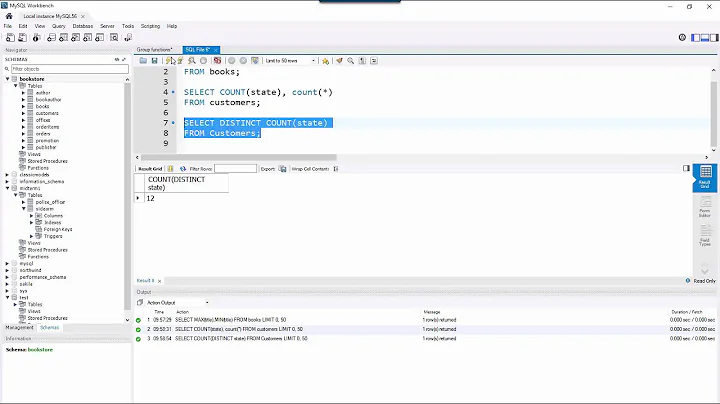Partition Function COUNT() OVER possible using DISTINCT
Solution 1
There is a very simple solution using dense_rank()
dense_rank() over (partition by [Mth] order by [UserAccountKey])
+ dense_rank() over (partition by [Mth] order by [UserAccountKey] desc)
- 1
This will give you exactly what you were asking for: The number of distinct UserAccountKeys within each month.
Solution 2
Necromancing:
It's relativiely simple to emulate a COUNT DISTINCT over PARTITION BY with MAX via DENSE_RANK:
;WITH baseTable AS
(
SELECT 'RM1' AS RM, 'ADR1' AS ADR
UNION ALL SELECT 'RM1' AS RM, 'ADR1' AS ADR
UNION ALL SELECT 'RM2' AS RM, 'ADR1' AS ADR
UNION ALL SELECT 'RM2' AS RM, 'ADR2' AS ADR
UNION ALL SELECT 'RM2' AS RM, 'ADR2' AS ADR
UNION ALL SELECT 'RM2' AS RM, 'ADR3' AS ADR
UNION ALL SELECT 'RM3' AS RM, 'ADR1' AS ADR
UNION ALL SELECT 'RM2' AS RM, 'ADR1' AS ADR
UNION ALL SELECT 'RM3' AS RM, 'ADR1' AS ADR
UNION ALL SELECT 'RM3' AS RM, 'ADR2' AS ADR
)
,CTE AS
(
SELECT RM, ADR, DENSE_RANK() OVER(PARTITION BY RM ORDER BY ADR) AS dr
FROM baseTable
)
SELECT
RM
,ADR
,COUNT(CTE.ADR) OVER (PARTITION BY CTE.RM ORDER BY ADR) AS cnt1
,COUNT(CTE.ADR) OVER (PARTITION BY CTE.RM) AS cnt2
-- Not supported
--,COUNT(DISTINCT CTE.ADR) OVER (PARTITION BY CTE.RM ORDER BY CTE.ADR) AS cntDist
,MAX(CTE.dr) OVER (PARTITION BY CTE.RM ORDER BY CTE.RM) AS cntDistEmu
FROM CTE
Note:
This assumes the fields in question are NON-nullable fields.
If there is one or more NULL-entries in the fields, you need to subtract 1.
Solution 3
I use a solution that is similar to that of David above, but with an additional twist if some rows should be excluded from the count. This assumes that [UserAccountKey] is never null.
-- subtract an extra 1 if null was ranked within the partition,
-- which only happens if there were rows where [Include] <> 'Y'
dense_rank() over (
partition by [Mth]
order by case when [Include] = 'Y' then [UserAccountKey] else null end asc
)
+ dense_rank() over (
partition by [Mth]
order by case when [Include] = 'Y' then [UserAccountKey] else null end desc
)
- max(case when [Include] = 'Y' then 0 else 1 end) over (partition by [Mth])
- 1
An SQL Fiddle with an extended example can be found here.
Solution 4
I think the only way of doing this in SQL-Server 2008R2 is to use a correlated subquery, or an outer apply:
SELECT datekey,
COALESCE(RunningTotal, 0) AS RunningTotal,
COALESCE(RunningCount, 0) AS RunningCount,
COALESCE(RunningDistinctCount, 0) AS RunningDistinctCount
FROM document
OUTER APPLY
( SELECT SUM(Amount) AS RunningTotal,
COUNT(1) AS RunningCount,
COUNT(DISTINCT d2.dateKey) AS RunningDistinctCount
FROM Document d2
WHERE d2.DateKey <= document.DateKey
) rt;
This can be done in SQL-Server 2012 using the syntax you have suggested:
SELECT datekey,
SUM(Amount) OVER(ORDER BY DateKey) AS RunningTotal
FROM document
However, use of DISTINCT is still not allowed, so if DISTINCT is required and/or if upgrading isn't an option then I think OUTER APPLY is your best option
Solution 5
There is a solution in simple SQL:
SELECT time, COUNT(DISTINCT user) OVER(ORDER BY time) AS users
FROM users
=>
SELECT time, COUNT(*) OVER(ORDER BY time) AS users
FROM (
SELECT user, MIN(time) AS time
FROM users
GROUP BY user
) t
Related videos on Youtube
whytheq
Current addictions: DAX / POWERSHELL Time served with: (T-)sql / MDX / VBA / SSRS Would like more time for the following: C# Python Maxim: if you build something idiot-proof, the world will build a better idiot
Updated on February 03, 2022Comments
-
whytheq over 2 years
I'm trying to write the following in order to get a running total of distinct NumUsers, like so:
NumUsers = COUNT(DISTINCT [UserAccountKey]) OVER (PARTITION BY [Mth])Management studio doesn't seem too happy about this. The error disappears when I remove the
DISTINCTkeyword, but then it won't be a distinct count.DISTINCTdoes not appear to be possible within the partition functions. How do I go about finding the distinct count? Do I use a more traditional method such as a correlated subquery?Looking into this a bit further, maybe these
OVERfunctions work differently to Oracle in the way that they cannot be used inSQL-Serverto calculate running totals.I've added a live example here on SQLfiddle where I attempt to use a partition function to calculate a running total.
-
 Damien_The_Unbeliever almost 12 years
Damien_The_Unbeliever almost 12 yearsCOUNTwithORDER BYinstead ofPARTITION BYis ill-defined in 2008. I'm surprised it's letting you have it at all. Per the documentation, you're not allowed anORDER BYfor an aggregate function. -
whytheq almost 12 yearsyep - think I'm getting confused with some oracle functionality; these running totals and running counts will be a little more involved
-
-
whytheq almost 12 yearscool thank you. I found this SO answer which features the OUTER APPLY option which I will attempt. Have you seen the looping UPDATE approach in that answer ... it's pretty far out & apparently fast. Life will be easier in 2012 - is that a straight Oracle copy?
-
 bf2020 about 10 yearsOne thing to be careful about with
bf2020 about 10 yearsOne thing to be careful about withdense_rank()is that it will count NULLs whereasCOUNT(field) OVERdoes not. I can't employ it in my solution because of this but I still think it's quite clever. -
whytheq almost 8 yearsBut I'm looking for a running total of distinct useraccountkeys over the months of each year: not sure how this answers that?
-
 Vladimir Baranov almost 7 years@bf2020, if there can be
Vladimir Baranov almost 7 years@bf2020, if there can beNULLvalues in theUserAccountKey, then you need to add this term:-MAX(CASE WHEN UserAccountKey IS NULL THEN 1 ELSE 0 END) OVER (PARTITION BY Mth). Idea is taken from the answer by LarsRönnbäck below. Essentially, ifUserAccountKeyhasNULLvalues, you need to subtract extra1from the result, becauseDENSE_RANKcounts NULLs. -
 Vladimir Baranov almost 7 yearsYour idea can be used to make the original formula (without complexities of
Vladimir Baranov almost 7 yearsYour idea can be used to make the original formula (without complexities of[Include]that you are talking about in your answer) withdense_rank()work whenUserAccountKeycan beNULL. Add this term to the formula:-MAX(CASE WHEN UserAccountKey IS NULL THEN 1 ELSE 0 END) OVER (PARTITION BY Mth). -
K4M over 3 yearsHere a discussion of using this
dense_ranksolution when window function has a frame. SQL Server does not allowdense_rankused with a window frame: stackoverflow.com/questions/63527035/…









